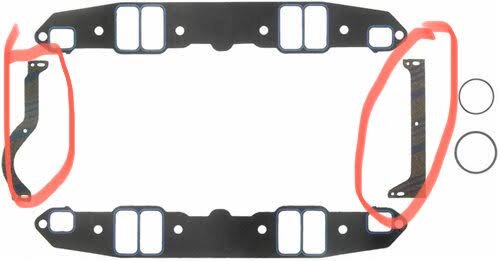Take your housing, a piece of sandpaper on a truly flat surface and “lightly” sand it flat in a random orbital motion ensuring you keep centralized downward pressure. Some sandpaper (adhesive backed preferably) on a hardwood block of wood and scuff up the intakes thermostat surface until you see a uniform finish.
I don’t use FelPro blue colored gaskets, use the thicker gray style. Use a skim coat of ultra black on both sides of the gasket, bolt it down and let it fully cure before refilling with liquids. I Never ever have any leaks, weeping etc no matter what intake, style of thermostat used. Never Ever.
Someone’s got leaks it’s because any number of reasons: the surfaces aren’t truly flat, uniform, clean, aren’t tightening the bolts evenly, to the right tightness, the bolts are bottoming out, not letting it dry.
If someone is installing an out of the box thermostat housing on an ootb intake without verifying flat surfaces, bolt length, proper sealant application (I’ve actually installed with no sealant, simply a dry gasket in some cases) and cure time they are not doing things right.
If one thinks they shouldn’t have to do additional “fixes” on these specific new parts well then just keep installing, filling, leaking, draining, removing, replacing until you find the “ones” Check, fix, install, done. The first time.
In all reality you are correct, the Gasket should be installed dry, just did this on my 99 Cherokee, no leaks.
True, new pieces need to be checked before use. I test for true and straightness on a sheet of glass, many brand new are not up to snuff.
The only ones I have ever fought with are small block Chryslers with aftermarket intakes, not sure why but this is the case. I tried dry gasket, thicker gasket, rtv, rtv and gasket, The "Real" gasket, etc. I finally bought the Billet Specialties o-ringed housing and it sealed. For me this is now the go to to save the aggravation.
I don't suggest by this post anything you have said to be incorrect, I just know I have struggled with this myself and it is exceedingly frustrating for what should be something very simple.


















